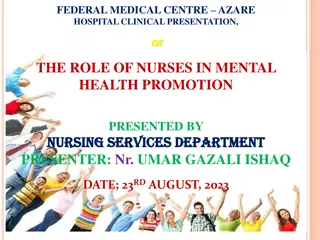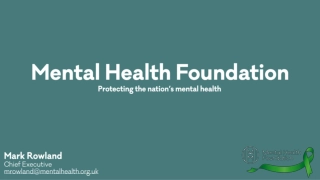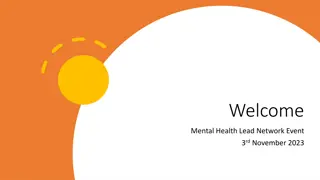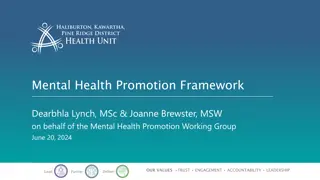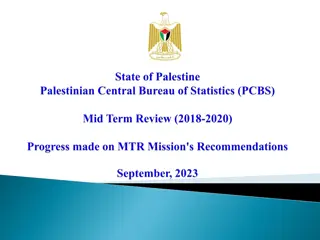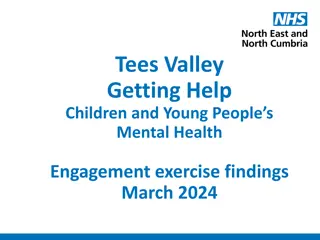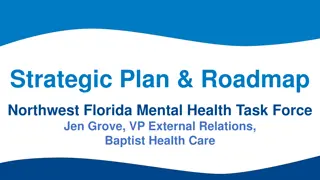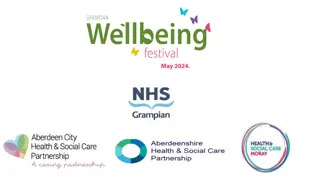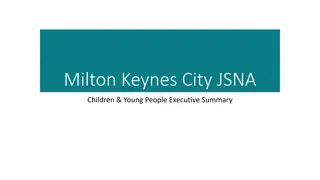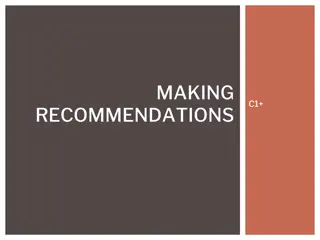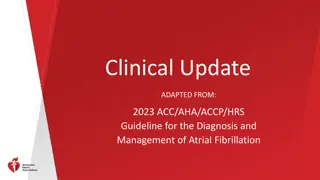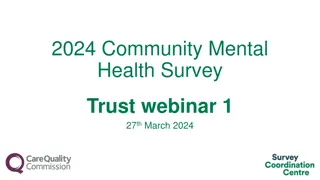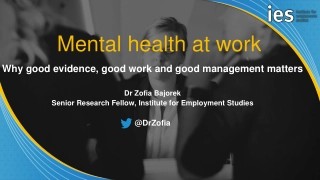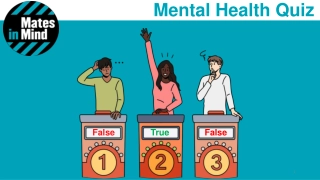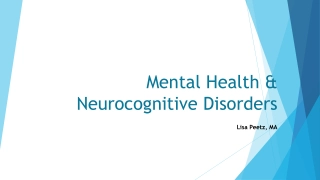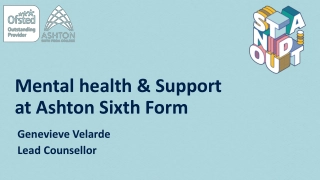Understanding Mental Health Development According to WHO Recommendations
Explore developmental milestones in mental health, from physical to cognitive and social-emotional aspects. Understand the impact of trauma on development, recognize mental health problems related to developmental issues, and learn about standardized practices and tools for screening in the CHW scope. Discover how physical, cognitive, and social-emotional milestones play a vital role in a child's growth and well-being.
Download Presentation
Please find below an Image/Link to download the presentation.
The content on the website is provided AS IS for your information and personal use only. It may not be sold, licensed, or shared on other websites without obtaining consent from the author. Download presentation by click this link. If you encounter any issues during the download, it is possible that the publisher has removed the file from their server.
Presentation Transcript
Health Focus: Mental Health What is Development? Based upon the World Health Organization recommendations
HEALTH FOCUS: MENTAL HEALTH MH.1 What is Development? MH.2 What is Mental Illness? MH.3 Introduction to the Treatment of Mental Health Problems MH.4 Understanding Substance Abuse
WORDS TO KNOW Mental Health Behavioral Health Neurotransmitter Amygdala Prefrontal cortex Cognitive
MH.1 OBJECTIVES At the completion of the unit, the student will be able to: Describe the differences among developmental milestones: physical, cognitive, social and emotional. Understand how trauma, abuse and neglect interrupts development and impacts a child s development and growth Explain how developmental problem may be associated to Mental Health problems.
MH.1OBJECTIVES At the completion of the unit, the student will be able to: Recognize the existence of standardized developmental and mental health practices and screening tools and their application in the CHW scope of practice. Help community members finding appropriate anticipatory guidance for parents of children at each stage of development and suggest appropriate referral strategies for common behavioral problems.
BRAIN BUILDERS https://www.youtube.com/watch?v=23jDxNOdDCk
PHYSICAL MILESTONES Involve both large-motor skills and fine-motor skills. The large-motor skills are usually the first to develop and include sitting up, standing, crawling and walking. Fine-motor skills involve precise movements such as grasping a spoon, holding a crayon, drawing shapes and picking up small objects.
COGNITIVE MILESTONES Centered on a child's ability to think, learn and solve problems. An infant learning how to respond to facial expressions and a preschooler learning the alphabet are both examples of cognitive milestones.
SOCIAL EMOTIONAL MILESTONES Centered on children gaining a better understanding of their own emotions and the emotions of others. These milestones also involve learning how to interact and play with other people.
COMMUNICATION MILESTONES Involve both language and nonverbal communication. A one-year old learning how to say his first words and a five year old learning some of the basic rules of grammar are examples of important communication milestones.
PHYSICAL MILESTONES: BIRTH TO 3 MONTHS Use rooting, sucking and grasping reflexes Slightly raise the head when lying on the stomach Hold head up for a few seconds with support Clench hands into fists Tug and pull on their own hands Repeat body movements
PHYSICAL MILESTONES: 9 TO 12 MONTHS In addition to the major milestones such as standing up and walking, children also begin to develop more advanced fine-motor skills. In this window of development, most babies are able to: Sit up unaided Stand without assistance Walk without help Pick up and throw objects Roll a ball Pick up objects between their thumb and one finger
COGNITIVE MILESTONES Represent important steps forward in intellectual skills of young children and adolescents. Childhood and adolescence are a unique period of cognitive growth and development. Implies that babies are in fact always learning, thinking and exploring the world around them at an expected rate.
COGNITIVE MILESTONES: BIRTH TO 3 MONTHS During this period, most infants begin to: See objects more clearly within a distance of 13 inches Focus on moving objects, including the faces of caregivers Tell between sweet, salty, bitter and sour tastes Detect differences in pitch and volume See all colors in the human visual spectrum Respond to their environment with facial expressions Demonstrate anticipatory behaviors to rooting and sucking at the site of a nipple or bottle
COGNITIVE MILESTONES: 9 TO 12 MONTHS As they approach one year of age, most infants are able to: Understand the concept of object permanence Imitate gestures and some basic actions Respond with gestures and sounds Enjoy looking at picture books Manipulate objects by turning them over, trying to put one object into another
SOCIAL/EMOTIONAL MILESTONES: BIRTH TO 3 MONTHS It is measured by skill building and this involves: Looking at the part of their body that a parents or caregiver is touching Understanding how the legs and arms are attached Realizing that they are separate beings from those around them Learning to be comforted and soothed by adults Enjoying social stimulation and smiling at people
SOCIAL/EMOTIONAL MILESTONES: 9 TO 12 MONTHS Most kids can: Hold a cup and drink with help Imitate simple actions Feed themselves small bites of food Express anxiety when separated from parents or caregivers Self-regulation becomes increasingly important as the child approaches one year of age
ON THE RADIO: CHILDHOOD STRESS MAY PRIME PUMP FOR CHRONIC DISEASE LATER 4 VOLUNTEERS PLEASE
DEFINITION OF POVERTY Economic definition is based on income measures Broader definition suggests that poor means lacking not only material assets and good health, but also capabilities such as social belonging, cultural identity, respect and dignity.
HYPOTHESIZED RELATIONS http://www.who.int/maternal_child_adolescent/documents/lancet_child_development/en/
RESEARCH ACTIVITY Kansas Behavioral Health Barometer www.samhsa.gov Read & interpret the data together. Small group reports Surprises? Why CHW needs to know How will you handle?
RECOGNIZING THE EXISTENCE OF STANDARDIZED DEVELOPMENTAL AND MENTAL HEALTH PRACTICES AND SCREENING TOOLS Source: CDC http://www.cdc.gov
STANDARDIZED DEVELOPMENTAL PRACTICES: ACTIVITY Source: CDC http://www.cdc.gov/ncbddd/childdevelopment/screening-hcp.html
GO TO: "LEARN THE SIGNS. ACT EARLY" CAMPAIGN HTTP://WWW.CDC.GOV/NCBDDD/ACTEARLY/FREEMATERIALS.HTML
WHERE CAN YOU FIND HELP IN YOUR COMMUNITY You can help community members finding appropriate guidance for parents of children at each stage of development in the Centers for Disease Control (cdc.gov) Examples of appropriate referral strategies for common behavioral problems should always start at the primary care level.
PRACTICE Visit www.mentalhealth.gov Bring back an interesting piece of data to share at the next class. Bring back a local Mental Health Resource to share.
FEEDBACK Please provide your feedback and suggestions on a piece of paper and turn it in to your instructor. THANK YOU! Next session: What is Mental Illness?
This presentation was created by Metropolitan Community College Kansas City for use with the Community Health Worker training program. Background design has been changed. Unless otherwise noted this material is licensed under a Creative Commons Attribution 4.0 International License.








